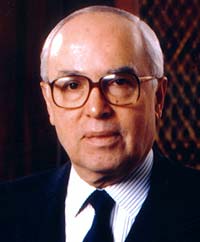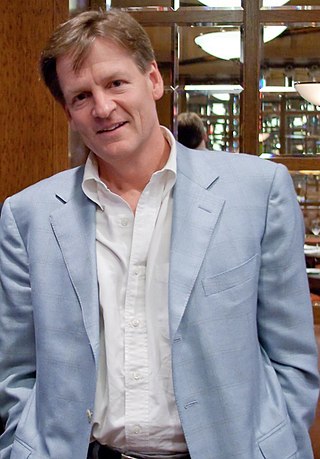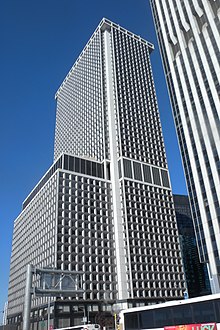
Morgan Stanley is an American multinational investment bank and financial services company headquartered at 1585 Broadway in Midtown Manhattan, New York City. With offices in 41 countries and more than 75,000 employees, the firm's clients include corporations, governments, institutions, and individuals. Morgan Stanley ranked No. 61 in the 2023 Fortune 500 list of the largest United States corporations by total revenue and in the same year ranked #30 in Forbes Global 2000.
EF Hutton was an American stock brokerage firm founded in 1904 by Edward Francis Hutton and his brother, Franklyn Laws Hutton. Later, it was led by well known Wall Street trader Gerald M. Loeb. Under their leadership, EF Hutton became one of the most respected financial firms in the United States and for several decades was the second largest brokerage firm in the country.

Citigroup Inc. or Citi is an American multinational investment bank and financial services corporation incorporated in Delaware and headquartered in New York City. The company was formed by the merger of Citicorp, the bank holding company for Citibank, and Travelers in 1998; Travelers was spun off from the company in 2002.

Liar's Poker is a non-fiction, semi-autobiographical book by Michael Lewis describing the author's experiences as a bond salesman on Wall Street during the late 1980s. First published in 1989, it is considered one of the books that defined Wall Street during the 1980s, along with Bryan Burrough and John Helyar's Barbarians at the Gate: The Fall of RJR Nabisco, and the fictional The Bonfire of the Vanities by Tom Wolfe. The book captures an important period in the history of Wall Street. Two important figures in that history feature prominently in the text, the head of Salomon Brothers' mortgage department Lewis Ranieri and the firm's CEO John Gutfreund.
Morgan Stanley Wealth Management is an American multinational financial services corporation specializing in retail brokerage. It is the wealth & asset management division of Morgan Stanley. On January 13, 2009, Morgan Stanley and Citigroup announced that Citigroup would sell 51% of Smith Barney to Morgan Stanley, creating Morgan Stanley Smith Barney, which was formerly a division of Citi Global Wealth Management. The combined brokerage house has 17,646 financial advisors and manages $2 trillion in client assets. Clients range from individual investors to small- and mid-sized businesses, as well as large corporations, non-profit organizations and family foundations.

Lehman Brothers Inc. was an American global financial services firm founded in 1850. Before filing for bankruptcy in 2008, Lehman was the fourth-largest investment bank in the United States, with about 25,000 employees worldwide. It was doing business in investment banking, equity, fixed-income and derivatives sales and trading, research, investment management, private equity, and private banking. Lehman was operational for 158 years from its founding in 1850 until 2008.

Bulge bracket banks are the world's largest global investment banks, serving mostly large corporations, institutional investors and governments. The term "Bulge Bracket" comes from the way investment banks are listed on the "tombstone", or public notification of a financial transaction;, where the largest advisors on investment banking operations are listed first. The term is primarily related to the financial advisory side of the business, as opposed to sales and trading.
A collateralized debt obligation (CDO) is a type of structured asset-backed security (ABS). Originally developed as instruments for the corporate debt markets, after 2002 CDOs became vehicles for refinancing mortgage-backed securities (MBS). Like other private label securities backed by assets, a CDO can be thought of as a promise to pay investors in a prescribed sequence, based on the cash flow the CDO collects from the pool of bonds or other assets it owns. Distinctively, CDO credit risk is typically assessed based on a probability of default (PD) derived from ratings on those bonds or assets.
Dean Witter Reynolds was an American stock brokerage and securities firm catering to a variety of clients. Prior to the company's acquisition, it was among the largest firms in the securities industry with over 9,000 account executives and was among the largest members of the New York Stock Exchange. The company served over 3.2 million clients primarily in the U.S. Dean Witter provided debt and equity underwriting and brokerage as mutual funds and other saving and investment products for individual investors. The company's asset management arm, Dean Witter InterCapital, with total assets of $90.0 billion prior to the acquisition, was one of the largest asset management operations in the U.S.

Drexel Burnham Lambert Inc. was an American multinational investment bank that was forced into bankruptcy in 1990 due to its involvement in illegal activities in the junk bond market, driven by senior executive Michael Milken. At its height, it was a Bulge Bracket bank, as the fifth-largest investment bank in the United States.

Schroders plc is a British multinational asset management company headquartered in London, England. Founded in 1804, it employs over 6,000 people worldwide in 38 locations around Europe, America, Asia, Africa and the Middle East. It is traded on the London Stock Exchange and is a constituent of the FTSE 100 Index.

John Halle Gutfreund was an American banker, businessman, and investor. He was the CEO of Salomon Brothers Inc, an investment bank that gained prominence in the 1980s. Gutfreund turned Salomon Brothers from a private partnership into a publicly traded corporation, which started a trend in Wall Street for investment companies to go public. In 1985, Business Week gave him the nickname "King of Wall Street".

Michael Monroe Lewis is an American author and financial journalist. He has also been a contributing editor to Vanity Fair since 2009, writing mostly on business, finance, and economics. He is known for his nonfiction work, particularly his coverage of financial crises and behavioral finance.

Residential mortgage-backed security (RMBS) are a type of mortgage-backed security backed by residential real estate mortgages.
Thomas (Tom) G. Maheras is an American finance executive that is currently a managing partner of Tegean Capital Management, LLC, a New York-based hedge fund.

Sir Deryck Charles Maughan is an English businessman.

Shearson was the name of a series of investment banking and retail brokerage firms from 1902 until 1994, named for Edward Shearson and the firm he founded, Shearson Hammill & Co. Among Shearson's most notable incarnations were Shearson / American Express, Shearson Lehman / American Express, Shearson Lehman Brothers, Shearson Lehman Hutton and finally Smith Barney Shearson.
Lewis S. Ranieri is a former bond trader, and founding partner and current chairman of Ranieri Partners, a real estate firm.
Cogan, Berlind, Weill & Levitt, originally Carter, Berlind, Potoma & Weill, was an American investment banking and brokerage firm founded in 1960 and acquired by American Express in 1981. In its two decades as an independent firm, Cogan, Berlind, Weill & Levitt served as a vehicle for the rollup of more than a dozen brokerage and securities firms led by Sanford I. Weill that culminated in the formation of Shearson Loeb Rhoades.
Wertheim & Co. was an investment firm founded in 1927 by Maurice Wertheim and Joseph Klingenstein, who met when they worked together at Hallgarten & Company. The firm engaged primarily in the merchant-banking business; it invested from its formation until the deaths of Wertheim and one of his senior partners in 1950 and 1952 respectively.













